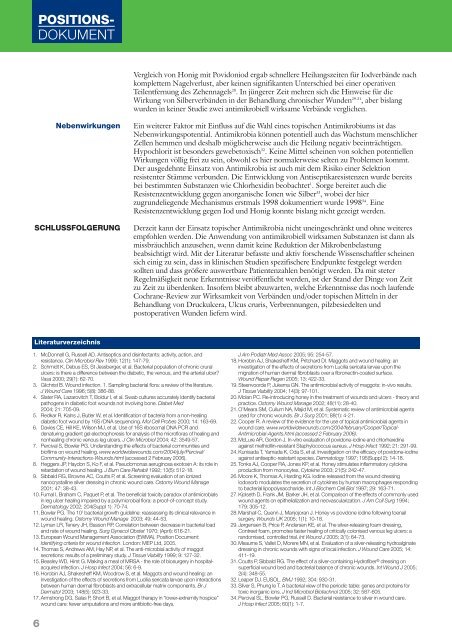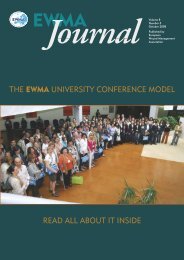Management von Wundinfektionen - EWMA
Management von Wundinfektionen - EWMA
Management von Wundinfektionen - EWMA
Sie wollen auch ein ePaper? Erhöhen Sie die Reichweite Ihrer Titel.
YUMPU macht aus Druck-PDFs automatisch weboptimierte ePaper, die Google liebt.
POSITIONS-<br />
DOKUMENT<br />
Vergleich <strong>von</strong> Honig mit Povidoniod ergab schnellere Heilungszeiten für Iodverbände nach<br />
komplettem Nagelverlust, aber keinen signifikanten Unterschied bei einer operativen<br />
Teilentfernung des Zehennagels 28 . In jüngerer Zeit mehren sich die Hinweise für die<br />
Wirkung <strong>von</strong> Silberverbänden in der Behandlung chronischer Wunden 29-31 , aber bislang<br />
wurden in keiner Studie zwei antimikrobiell wirksame Verbände verglichen.<br />
Nebenwirkungen<br />
SCHLUSSFOLGERUNG<br />
Ein weiterer Faktor mit Einfluss auf die Wahl eines topischen Antimikrobiums ist das<br />
Nebenwirkungspotential. Antimikrobia können potentiell auch das Wachstum menschlicher<br />
Zellen hemmen und deshalb möglicherweise auch die Heilung negativ beeinträchtigen.<br />
Hypochlorit ist besonders gewebetoxisch 32 . Keine Mittel scheinen <strong>von</strong> solchen potentiellen<br />
Wirkungen völlig frei zu sein, obwohl es hier normalerweise selten zu Problemen kommt.<br />
Der ausgedehnte Einsatz <strong>von</strong> Antimikrobia ist auch mit dem Risiko einer Selektion<br />
resistenter Stämme verbunden. Die Entwicklung <strong>von</strong> Antiseptikaresistenzen wurde bereits<br />
bei bestimmten Substanzen wie Chlorhexidin beobachtet 1 . Sorge bereitet auch die<br />
Resistenzentwicklung gegen anorganische Ionen wie Silber 33 , wobei der hier<br />
zugrundeliegende Mechanismus erstmals 1998 dokumentiert wurde 1998 34 . Eine<br />
Resistenzentwicklung gegen Iod und Honig konnte bislang nicht gezeigt werden.<br />
Derzeit kann der Einsatz topischer Antimikrobia nicht uneingeschränkt und ohne weiteres<br />
empfohlen werden. Die Anwendung <strong>von</strong> antimikrobiell wirksamen Substanzen ist dann als<br />
missbräuchlich anzusehen, wenn damit keine Reduktion der Mikrobenbelastung<br />
beabsichtigt wird. Mit der Literatur befasste und aktiv forschende Wissenschaftler scheinen<br />
sich einig zu sein, dass in klinischen Studien spezifischere Endpunkte festgelegt werden<br />
sollten und dass größere auswertbare Patientenzahlen benötigt werden. Da mit steter<br />
Regelmäßigkeit neue Erkenntnisse veröffentlicht werden, ist der Stand der Dinge <strong>von</strong> Zeit<br />
zu Zeit zu überdenken. Insofern bleibt abzuwarten, welche Erkenntnisse das noch laufende<br />
Cochrane-Review zur Wirksamkeit <strong>von</strong> Verbänden und/oder topischen Mitteln in der<br />
Behandlung <strong>von</strong> Druckulcera, Ulcus cruris, Verbrennungen, pilzbesiedelten und<br />
postoperativen Wunden liefern wird.<br />
Literaturverzeichnis<br />
1. McDonnell G, Russell AD. Antiseptics and disinfectants: activity, action, and<br />
resistance. Clin Microbiol Rev 1999; 12(1): 147-79.<br />
2. Schmidt K, Debus ES, St Jessberger, et al. Bacterial population of chronic crural<br />
ulcers: is there a difference between the diabetic, the venous, and the arterial ulcer?<br />
Vasa 2000; 29(1): 62-70.<br />
3. Gilchrist B. Wound infection. 1. Sampling bacterial flora: a review of the literature.<br />
J Wound Care 1996; 5(8): 386-88.<br />
4. Slater RA, Lazarovitch T, Boldur I, et al. Swab cultures accurately identify bacterial<br />
pathogens in diabetic foot wounds not involving bone. Diabet Med<br />
2004; 21: 705-09.<br />
5. Redkar R, Kalns J, Butler W, et al. Identification of bacteria from a non-healing<br />
diabetic foot wound by 16S rDNA sequencing. Mol Cell Probes 2000; 14: 163-69.<br />
6. Davies CE, Hill KE, Wilson MJ, et al. Use of 16S ribosomal DNA PCR and<br />
denaturing gradient gel electrophoresis for analysis of the microfloras of healing and<br />
nonhealing chronic venous leg ulcers. J Clin Microbiol 2004; 42: 3549-57.<br />
7. Percival S, Bowler PG. Understanding the effects of bacterial communities and<br />
biofilms on wound healing. www.worldwidewounds.com/2004/july/Percival/<br />
Community-Interactions-Wounds.html (accessed 2 February 2006).<br />
8. Heggers JP, Haydon S, Ko F, et al. Pseudomonas aeruginosa exotoxin A: its role in<br />
retardation of wound healing. J Burn Care Rehabil 1992; 13(5): 512-18.<br />
9. Sibbald RG, Browne AC, Coutts P, et al. Screening evaluation of an ionized<br />
nanocrystalline silver dressing in chronic wound care. Ostomy Wound Manage<br />
2001; 47: 38-43.<br />
10.Fumal I, Braham C, Paquet P, et al. The beneficial toxicity paradox of antimicrobials<br />
in leg ulcer healing impaired by a polymicrobial flora: a proof-of-concept study.<br />
Dermatology 2002; 204(Suppl 1): 70-74.<br />
11.Bowler PG. The 10 5 bacterial growth guideline: reassessing its clinical relevance in<br />
wound healing. Ostomy Wound Manage 2003; 49: 44-53.<br />
12.Lyman LR, Tenery JH, Basson RP. Correlation between decrease in bacterial load<br />
and rate of wound healing. Surg Gynecol Obstet 1970; (April): 616-21.<br />
13.European Wound <strong>Management</strong> Association (<strong>EWMA</strong>). Position Document:<br />
Identifying criteria for wound infection. London: MEP Ltd, 2005.<br />
14.Thomas S, Andrews AM, Hay NP, et al. The anti-microbial activity of maggot<br />
secretions: results of a preliminary study. J Tissue Viability 1999; 9: 127-32.<br />
15.Beasley WD, Hirst G. Making a meal of MRSA - the role of biosurgery in hospitalacquired<br />
infection. J Hosp Infect 2004; 56: 6-9.<br />
16.Horobin AJ, Shakesheff KM, Woodrow S, et al. Maggots and wound healing: an<br />
investigation of the effects of secretions from Lucilia sericata larvae upon interactions<br />
between human dermal fibroblasts and extracellular matrix components. Br J<br />
Dermatol 2003; 148(5): 923-33.<br />
17.Armstrong DG, Salas P, Short B, et al. Maggot therapy in “lower-extremity hospice”<br />
wound care: fewer amputations and more antibiotic-free days.<br />
J Am Podiatr Med Assoc 2005; 95: 254-57.<br />
18.Horobin AJ, Shakesheff KM, Pritchard DI. Maggots and wound healing: an<br />
investigation of the effects of secretions from Lucilia sericata larvae upon the<br />
migration of human dermal fibroblasts over a fibronectin-coated surface.<br />
Wound Repair Regen 2005; 13: 422-33.<br />
19.Steenvoorde P, Jukema GN. The antimicrobial activity of maggots: in-vivo results.<br />
J Tissue Viability 2004; 14(3): 97-101.<br />
20.Molan PC. Re-introducing honey in the treatment of wounds and ulcers - theory and<br />
practice. Ostomy Wound Manage 2002; 48(11): 28-40.<br />
21.O’Meara SM, Cullum NA, Majid M, et al. Systematic review of antimicrobial agents<br />
used for chronic wounds. Br J Surg 2001; 88(1): 4-21.<br />
22.Cooper R. A review of the evidence for the use of topical antimicrobial agents in<br />
wound care. www.worldwidewounds.com/2004/february/Cooper/Topical-<br />
Antimicrobial-Agents.html (accessed 2 February 2006).<br />
23. McLure AR, Gordon J. In-vitro evaluation of povidone-iodine and chlorhexidine<br />
against methicillin-resistant Staphylococcus aureus. J Hosp Infect 1992; 21: 291-99.<br />
24.Kunisada T, Yamada K, Oda S, et al. Investigation on the efficacy of povidone-iodine<br />
against antiseptic-resistant species. Dermatology 1997; 195(Suppl 2): 14-18.<br />
25.Tonks AJ, Cooper RA, Jones KP, et al. Honey stimulates inflammatory cytokine<br />
production from monocytes. Cytokine 2003; 21(5): 242-47.<br />
26.Moore K, Thomas A, Harding KG. Iodine released from the wound dressing<br />
Iodosorb modulates the secretion of cytokines by human macrophages responding<br />
to bacterial lipopolysaccharide. Int J Biochem Cell Biol 1997; 29: 163-71.<br />
27.Kjolseth D, Frank JM, Barker JH, et al. Comparison of the effects of commonly used<br />
wound agents on epithelialization and neovascularization. J Am Coll Surg 1994;<br />
179: 305-12.<br />
28.Marshall C, Quenn J, Manjojoran J. Honey vs povidone iodine following toenail<br />
surgery. Wounds UK 2005; 1(1): 10-18.<br />
29.Jørgensen B, Price P, Andersen KE, et al. The silver-releasing foam dressing,<br />
Contreet foam, promotes faster healing of critically colonised venous leg ulcers: a<br />
randomised, controlled trial. Int Wound J 2005; 2(1): 64-73.<br />
30.Meaume S, Vallet D, Morere MN, et al. Evaluation of a silver-releasing hydroalginate<br />
dressing in chronic wounds with signs of local infection. J Wound Care 2005; 14:<br />
411-19.<br />
31.Coutts P, Sibbald RG. The effect of a silver-containing Hydrofiber ® dressing on<br />
superficial wound bed and bacterial balance of chronic wounds. Int Wound J 2005;<br />
2(4): 348-55.<br />
32.Leaper DJ. EUSOL. BMJ 1992; 304: 930-31.<br />
33.Silver S, Phung le T. A bacterial view of the periodic table: genes and proteins for<br />
toxic inorganic ions. J Ind Microbiol Biotechnol 2005; 32: 587-605.<br />
34.Percival SL, Bowler PG, Russell D. Bacterial resistance to silver in wound care.<br />
J Hosp Infect 2005; 60(1): 1-7.<br />
6
















